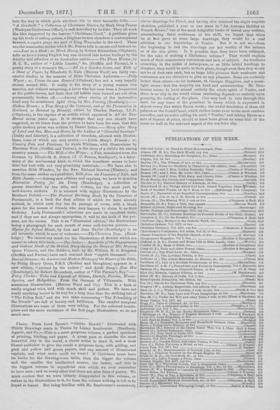Venice. From Lord tyron's "Childs Harold." Illustrated with 'Thirty Drawings
made in Vbnioe by Linley Sambourne. (Bradbury, Agnew, and Co.)—This is a most gorgeous volume, a perfect specimen of printing, binding, and paper. A. great poet to describe the most beautiful city in the world, a clever artist to draw it, and a most liberal publisher to give the result a gorgeous form, with gilding, and pink and yellow and green papers, and any amount of illuminated e apitals, and what more could wo want ? If Christmas must have its books for the drawing-room table, then the bigger the volume and the smaller the intellectual matter, the hotter, and this is the biggest volume in superficial area which we over remember to have seen ; and on every other loaf there are nine linos of poetry. Wo must confess that we were bitterly disappointed in this volume, or rather in the illustrations to it, for from the volume nothing is left to be hoped or feared. But being familiar with Mr. Sambourne's excessively clever drawings for Punch, and having also admired his slight wayside sketches, published a year or two since in "An Autumn Holiday on French Rivers," one of the most delightful books of travel ever written, remembering these evidences of his skill, we hoped that when he at Past gave us some largo drawings, they would be a real addition to oar knowledge of Venice. But it is not so,—from the beginning to end the drawings are not worthy of the subject or of the size given. Is it possible that they have been enlarged, for the sake of making a Christmas volume ? That would explain much of their unnecessary coarseness and lack of subject. As woodouts occurring in the midst of letterpress, or as little initial headings to chapters, they would be quite in their place, though oven then they would not be of first-rate rank, but as large folio pictures their weakness and coarseness are too obtrusive to give us any pleasure. Some are certainly better than others —as for instance, St. Georgio Maggiore, and a moon- light scone—but the majority are hard and uninteresting. Mr. Sam- bourne seems to have missed entirely the whole spirit of Venice, and there is no city in the world whose rendering depends so entirely upon grasping the fooling of the place. One may look in vain through this book for any trace of the grandeur in decay which is expressed in almost every lino which Byron wrote ; the awful desolation of those old palaces on the Grand Canal, which strikes home even to the most careless traveller, and an artist calling his work " Venice," and taking Byron as a sort of laquais de place, should at least have given us some hint of the inner es well as the outward aspect of the sea-born city.






































 Previous page
Previous page